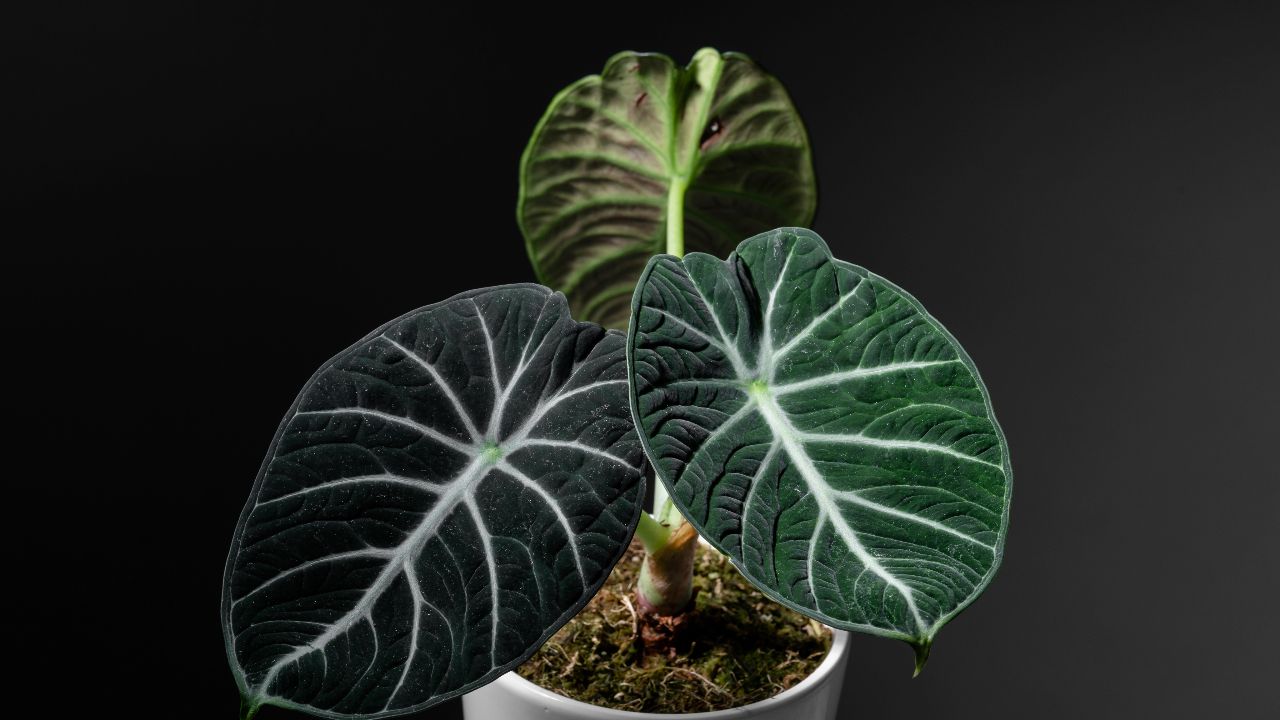
At a Glance: Alocasia Black Velvet
- Common Names: Alocasia Black Velvet, Black Velvet Elephant Ear
- Scientific Name: Alocasia reginula A.Hay
- Family: Araceae
- Plant Category: Herbaceous Perennial
- Adult Height: Grows up to 1.5 feet tall
- Sunlight Needs: Prefers Partial Sunlight
- Preferred Soil: Requires Well-Drained Soil
- Soil Acidity: Thrives in Acidic to Neutral Soil
- Flowering Period: Blooms Infrequently
- Flower Hue: Produces White Flowers
- Hardiness Zone: Suitable for USDA Zones 10 and above
- Native Region: Originates from Southeast Asia
- Safety: Harmful to Humans and Pets
The world of tropical plants offers a diverse palette of colors, textures, and forms. Yet, few stand out as majestically as the Alocasia Black Velvet. With its unique combination of velvety leaves adorned with intricate silvery veins, it's no surprise that the Alocasia Black Velvet is a rare gem coveted by plant enthusiasts. This majestic variety boasts an allure that few plants can match – the stunning dark green, almost black foliage offers a stark, enchanting contrast to the more common shades of green found in indoor gardens.
However, as with all precious things, the Alocasia Black Velvet demands meticulous care. One of the primary challenges faced by gardeners is the dreaded root rot. A consequence of overly moist soil or standing water, root rot can rapidly diminish the health of this tropical plant, leading to yellowing leaves and an overall weakened state. It's a sobering reminder that while the Black Velvet Alocasia enchants with its beauty, it also challenges our skills in plant care.
But don't let this deter you. The journey with the Alocasia Black Velvet is one of learning, growth, and ultimately, fulfillment. As we delve deeper into the world of this stunning plant, we'll arm you with the knowledge to ensure its optimal health and vitality. Whether you're a seasoned gardener or someone with proverbial "brown thumbs," with the right guidance, the Alocasia Black Velvet can become the jewel of your collection.
Join our newsletter
Stay on top of the latest in landscaping and lawn care with one valuable tip right in your inbox every Saturday morning.
The Magic of Black Velvet: Understanding Alocasia's Charm
In the vast universe of tropical plants, there lies a star that stands out with an inimitable brilliance – the Black Velvet Alocasia. While the Alocasia genus itself is abundant with uniquely patterned and shaped leaves, the black velvet variety has carved its niche, setting itself apart from other alocasia plants. But what exactly is it about this plant that captures the hearts of plant enthusiasts worldwide?
The answer lies in its striking physical attributes:
- Velvety Leaves: Touch an Alocasia Black Velvet, and you're met with the soft, luxurious feel akin to black velvet. This tactile allure makes it a favorite for those who appreciate plants beyond just their visual appeal.
- Silvery Veins: Adding to its mesmerizing charm, the dark, almost black leaves are etched with intricate, silvery veins. This creates a visual dance of contrast, making it an aesthetic centerpiece in any indoor garden.
- Dark Green, Almost Black Hue: Unlike many plants that boast vibrant greens, the Alocasia Black Velvet intrigues with its dark foliage, offering a bold statement in plant aesthetics.
The Black Velvet's unique characteristics make it a jewel alocasia, one that captivates not just with its beauty but with its story. As we venture further, we'll explore the depths of its charm and the secrets to nurturing this enigmatic plant to its full potential.
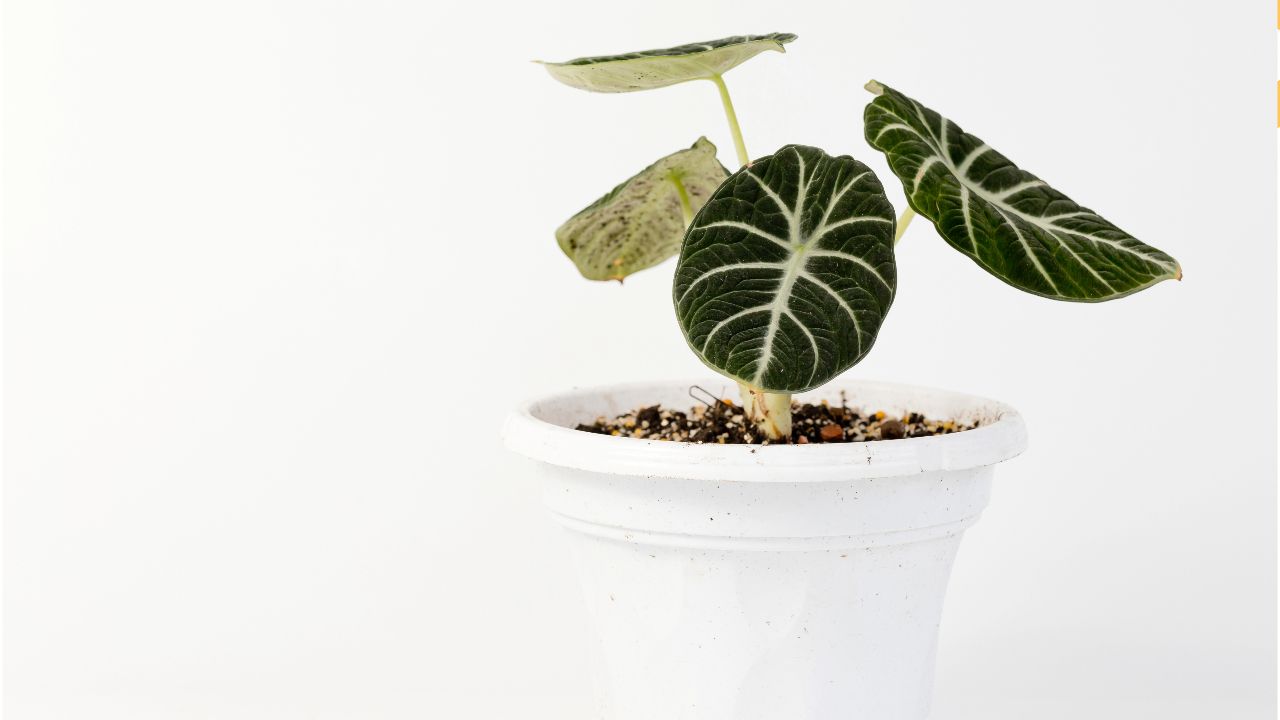
Bright Indirect Light: The Ideal Luminescence for Alocasia Black Velvet
Plant enthusiasts often find themselves in the dance of finding the right balance of light for their green companions. Among these, the Alocasia Black Velvet has an affinity towards a specific type of lighting that not only ensures its growth but enhances its unique aesthetic appeal: bright indirect light.
But why is bright indirect light the spotlight for alocasia plants, especially the Black Velvet variant?
- Harmony in Photosynthesis: Like all plants, Alocasia relies on photosynthesis, the process by which they transform light energy into food. The brightness ensures they receive ample energy, while the indirect nature ensures it's not overpowering.
- Preserving the Velvety Texture: Too much direct sunlight can compromise the delicate velvety texture of the Black Velvet's leaves. Indirect light helps maintain the tactile allure that many plant lovers appreciate.
Now, while our Alocasia Black Velvet thrives under bright indirect light, it's essential to understand the potential pitfalls of giving it too much direct sunlight:
- Risk of Leaf Tips Burning: The sun's rays can be too intense, causing the leaf tips to burn, resulting in unsightly brown or crispy leaf tips. It's a distress signal from the plant, indicating it's getting more light than it can handle.
- Fading of Silvery Veins: One of the Black Velvet's most captivating features is its intricate silvery veins. Direct sunlight can cause these to fade, diminishing the plant's visual appeal.
In the journey of plant care, understanding the light requirements of your Alocasia Black Velvet is paramount. The dance of luminescence isn't just about growth; it's about celebrating the radiant beauty of this unique plant in all its glory.
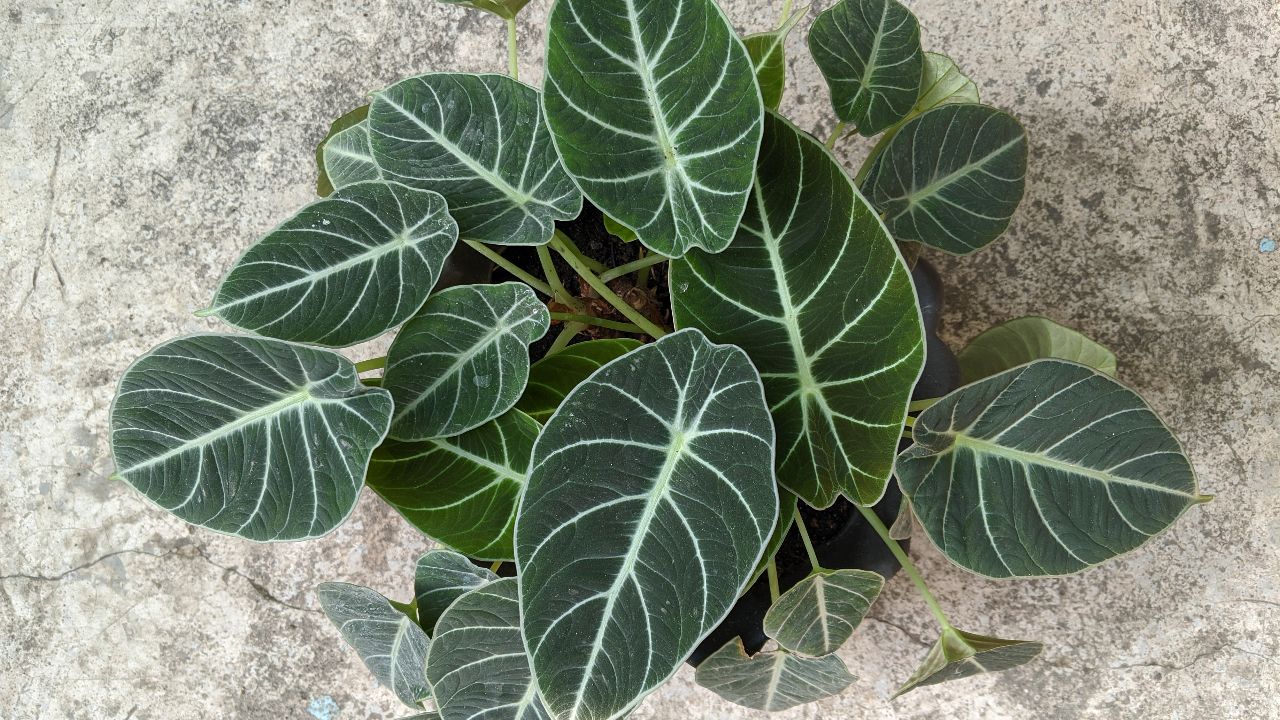
Orchid Bark's Role in Cultivating A Healthy Alocasia Black Velvet
In the vast world of plant care, each species comes with its own unique set of requirements. When it comes to the luxurious Alocasia Black Velvet, ensuring the perfect potting mix is key. Enter orchid bark, an often-overlooked component that can revolutionize the way we care for this tropical plant.
Here's why:
- Natural Breathability: Orchid bark offers an airy structure which allows the roots of the Alocasia Black Velvet to breathe. This ensures that the roots receive optimal oxygen, vital for robust growth.
- Prevention of Overly Moist Soil: One of the leading culprits of root rot in black velvet plants, and alocasia plants in general, is overly moist soil. Orchid bark has a natural ability to facilitate well-draining soil, thus preventing the Black Velvet's roots from staying submerged in water for extended periods. No more dreaded 'wet feet' for your prized plant!
- Mimicking Natural Habitats: Alocasia Black Velvet, like other jewel alocasias, originates from tropical regions. Orchid bark mirrors the natural ground cover they're accustomed to, making it feel right at home.
However, it's not just about the bark itself. Integrating orchid bark into a well-drained potting mix, alongside other components like coco coir, ensures the Alocasia Black Velvet thrives without the risk of developing root rot.
In essence, the simple inclusion of orchid bark in your potting soil can be the difference between a flourishing Alocasia Black Velvet, showcasing its dark green, velvety leaves and silvery veins, and one that struggles to survive. Embrace this natural tool and let your Alocasia shine!
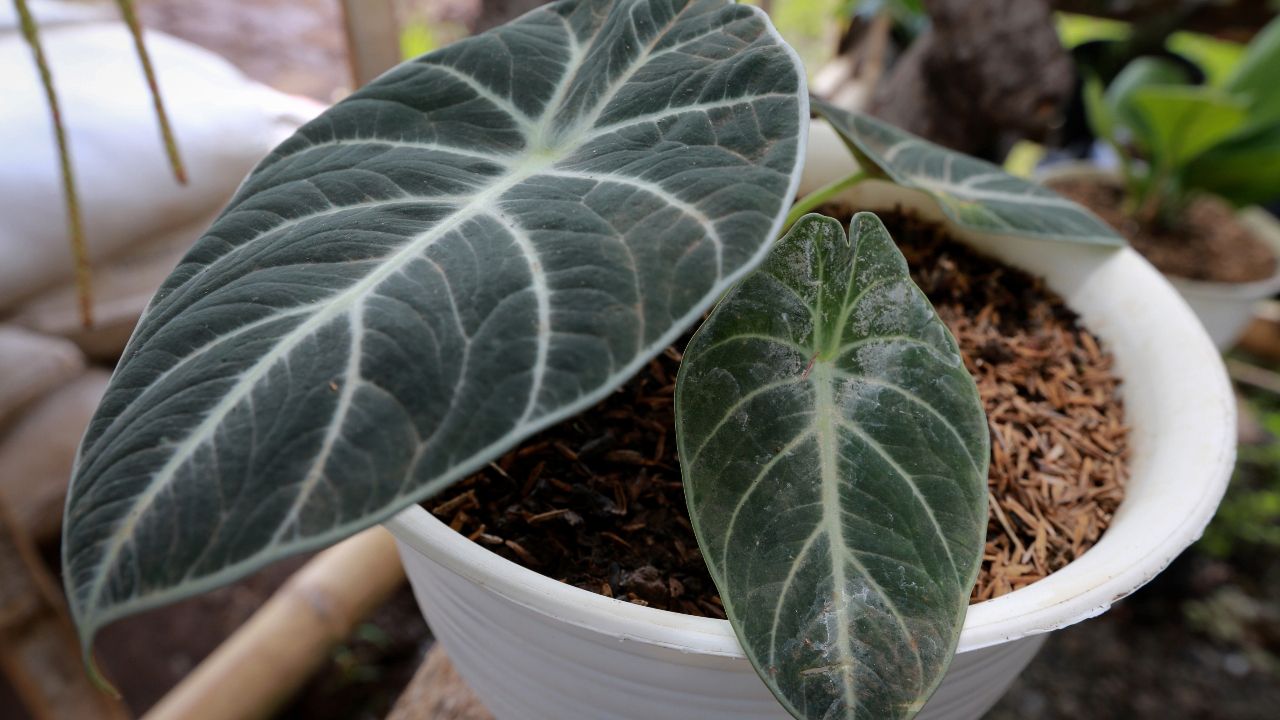
Root Rot Menace: Recognizing and Preventing The Silent Killer
Alocasia Black Velvet, with its captivating dark green leaves and intricate silvery veins, stands as one of the crowning jewels in the world of houseplants. But, like any treasure, it has its vulnerabilities. Among them, a silent and often overlooked menace lurks – root rot.
What is Root Rot? Root rot, at its core, is a fungal disease that attacks the roots of plants. It thrives in conditions where the soil is overly moist for extended periods, turning healthy white roots into soft, brown, decaying masses. For plants like the Alocasia Black Velvet, which prefer their soil moist but not wet, root rot can be a death sentence.
Recognizing the Signs in Alocasia Black Velvet: Though it originates beneath the surface, the signs of root rot soon manifest in the plant's appearance. Here's what to look out for:
- Brown Tips: While there can be various reasons for brown tips, combined with other symptoms, it's a red flag.
- Yellowing Leaves: If your Alocasia starts showing yellow leaves, especially at the bottom, it could be crying for help.
- Stunted Growth: A plant that's not growing during its growth season might be battling root rot.
Preventing the Dreaded Root Rot: Thankfully, prevention is better than cure, and there are proactive steps every plant enthusiast can take:
- Well-Draining Soil: Ensure your Alocasia Black Velvet is potted in a mix that drains well. Incorporating components like orchid bark can be a game-changer.
- Avoid Overwatering: Allow the top inch or two of the soil to dry out between watering sessions. Alocasias prefer to be slightly root bound, so don't rush to repot.
- Proper Potting: Use pots with adequate drainage holes. Standing water at the bottom is a haven for rot-inducing fungi.
In essence, while root rot might be a silent killer, armed with the right knowledge and care practices, your Alocasia Black Velvet can thrive, showcasing its mesmerizing beauty for all to see.
Join our newsletter
Stay ahead of the curve in all things outdoor.
Get the inside scoop on the latest landscaping, lawn care, and fencing trends with 1 actionable tip every Saturday morning.
Care Rituals: Ensuring Your Black Velvet Flourishes
In the resplendent realm of indoor plants, the Alocasia Black Velvet commands attention with its velvety leaves and silvery veins. While its beauty is undeniable, maintaining its lush allure requires a ritual of care and commitment. By embracing these monthly rituals and understanding its specific needs, you can ensure your Black Velvet not only survives but truly flourishes.
Monthly Spider Mite Checks: A common adversary of the Black Velvet is the spider mite. These microscopic pests can jeopardize the health of your plant, feeding on its precious sap. It's crucial to inspect the undersides of your plant's leaves monthly, keeping an eye out for any fine webs or tiny mites. If signs of a spider mite infestation are present, swift action can save your plant.
Maintain Soil Dryness: Overwatering is the Achilles heel for many tropical plants, including the Black Velvet. To prevent this, it's essential to ensure your soil is not retaining too much moisture. A simple monthly ritual involves poking your finger into the soil, ensuring the top two inches are dry before the next watering session.
Pebble Trays and Coco Coir: To recreate the tropical ambiance the Black Velvet craves, consider the use of pebble trays. By placing water-filled trays with pebbles beneath your plant pot, you create a micro-environment of elevated humidity. Additionally, incorporating coco coir into your potting mix can ensure a balanced moisture retention level without making the soil overly wet.
The Luminescence Balance: Direct sunlight can be harsh on your Black Velvet, causing its magnificent leaves to fade or even burn. Yet, they crave bright indirect light to truly shine. Position your plant in a spot where it can bask in filtered sunlight, perhaps shielded by sheer curtains or strategically placed away from the window's direct rays.
Embracing these care rituals will not only foster the growth of your Alocasia Black Velvet but also deepen your bond with this mesmerizing tropical beauty.
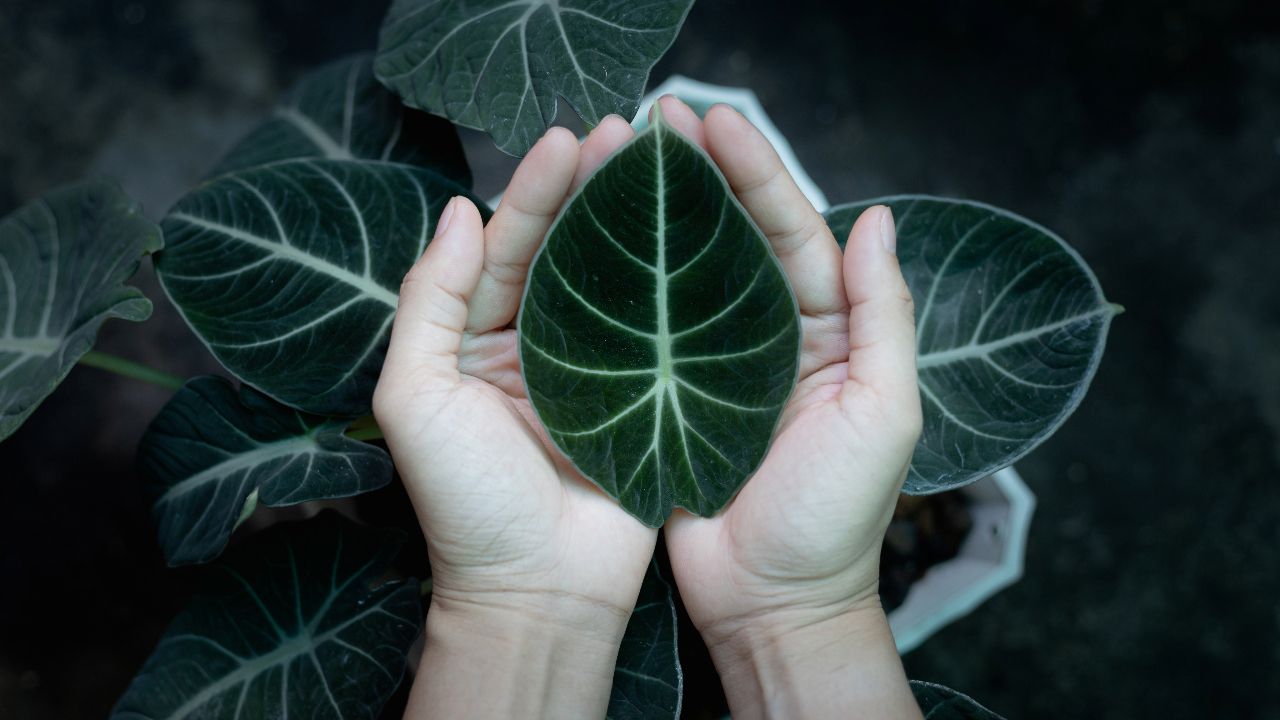
Propagation Magic: Growing More Alocasia Black Velvet from the Mother Plant
There's an undeniable charm in the art of propagation, especially when the specimen in question is the bewitching Alocasia Black Velvet. Those deep dark green leaves with silvery veins can leave plant lovers yearning for more. And the magic lies in the fact that, with a little care and knowledge, you can grow more of these beauties from your beloved mother plant.
The Joy of Propagation: The joy of alocasia black velvet propagation is twofold. Firstly, it's an economical way to multiply your collection of these rare jewels. Secondly, there's a deep sense of satisfaction in nurturing a new plant from the beginnings of its life, watching as it unfurls each new leaf, reflecting the distinct characteristics of the black velvet alocasia lineage.
Potting Rhizome Cuttings: The most common method for propagating Alocasia Black Velvet involves taking rhizome cuttings. These are essentially segments of the mother plant's root system. Once cut, these segments can develop into independent plants. When embarking on this journey, it's vital to use a well-drained potting mix. This ensures the young plant doesn't sit in overly moist soil, which could predispose it to root rot.
Tools Matter: For a successful propagation venture, the tools you use are as important as the technique. Using a clean knife is not just a recommendation—it's a necessity. This minimizes the risk of transmitting diseases and ensures a smooth cut that will heal and grow efficiently.
As your new Alocasia Black Velvet plant begins its life, remember to offer it the care rituals it needs. From ensuring soil dryness to protecting it from direct sunlight, your young plant will thrive in an environment of bright indirect light and love. Embrace the magic of propagation, and let your indoor garden bloom with more of these tropical wonders.
Common Challenges and Solutions: Navigating Alocasia Black Velvet Care
The Alocasia Black Velvet, with its captivating dark green leaves and silvery veins, is truly an ornamental gem for indoor plant enthusiasts. But like all rare treasures, it comes with its unique set of challenges. Successfully caring for the Alocasia Black Velvet requires a blend of vigilance, understanding, and swift action to address the occasional hiccups in its growth journey.
The Pesky Critters: Spider Mite Infestation One of the primary concerns with Alocasia Black Velvet care is the potential for spider mite infestation. These tiny pests thrive in low-humidity environments and can quickly compromise the health of your plant. Yellowing leaves and web-like structures are tell-tale signs. But fear not! With regular checks and some natural remedies, these can be kept at bay.
The Aesthetic Woes: Crispy Leaf Tips and Fertilizer Burn Crispy leaf tips often signal that your Alocasia Black Velvet is yearning for more humidity or is being exposed to cold drafts. These plants are tropical wonders and thrive best when their environment mimics their native habitat. On the other hand, too much enthusiasm with fertilizers can lead to the dreaded fertilizer burn. Striking a balance in nutrition is key.
The Ideal Environment: High Humidity and Warmth The importance of maintaining high humidity cannot be stressed enough for these plants. Simple measures like using a pebble tray or a room humidifier can make a world of difference. Simultaneously, keeping your Alocasia Black Velvet away from cold drafts will ensure those velvety leaves remain lush and vibrant.
In conclusion, while the Alocasia Black Velvet might pose some challenges, armed with the right knowledge and timely action, these hurdles can easily be overcome. Embrace the journey of caring for this jewel, and with each challenge navigated, you'll find the experience richer and more rewarding. Your flourishing plant will stand as a testament to your dedication and love.
Reveling in the Glory of a Well-Tended Alocasia Black Velvet
As the journey with your Alocasia Black Velvet unfolds, take a moment to bask in the ethereal beauty of its velvety leaves, shimmering with silvery veins. There’s undeniable magic in seeing this tropical gem flourish, especially when it remains untouched by the dreaded root rot. It’s not just about maintaining a plant; it’s about nurturing a living piece of art.
The key lies in evolving with your Alocasia Black Velvet. As with all things in nature, it's about understanding, learning, and adapting. Conditions change, environments fluctuate, and new challenges emerge. Yet, with every hurdle crossed, the bond with your plant deepens. The process instills a profound sense of accomplishment, turning each leaf's pristine health into a testament to your care and dedication.
Moreover, never hesitate to revisit and refine your care techniques. Plants, like humans, have their own rhythms and needs, and being attuned to them is essential. Dive deep into forums, connect with other Alocasia enthusiasts, and always be open to learning. The beauty of gardening lies as much in the process as in the result.
In the end, the flourishing Alocasia Black Velvet stands as a symbol—a reflection of patience, love, and commitment. Let its dark, velvety leaves serve as a daily reminder of the wonders that await when passion meets persistence.
Join our newsletter
Stay ahead of the curve in all things outdoor.
Get the inside scoop on the latest landscaping, lawn care, and fencing trends with 1 actionable tip every Saturday morning.